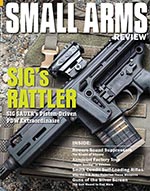Guns of the Silver Screen: V22N4
By Kyle Shea
The Gun Meant to End Wars
When the atomic bombs were dropped on Hiroshima and Nagasaki, it changed warfare forever. Before the bombs were dropped, the Americans and the Russians could have attacked each on the battlefield over any of the countless diplomatic incidents during the Cold War. Yet, the fear of nuclear assured destruction kept the two great superpowers from clashing in Cuba, Vietnam, Korea, Afghanistan and other conflicts across the world.
Almost 80 years before the development of the atomic bomb, a man named Dr. Richard J. Gatling attempted to create a weapon that would make men hesitate before going to war; much like the Atomic bomb did for much of the 20th century. The result was the Gatling gun. How it worked was simple. You simply cranked the handle on the side and turned the barrels, loading from a magazine on top and ejecting the spent cartridges below.
The Gatling gun was one of the great guns that helped the European powers become colonial empires. They were first used in the American Civil War, though they did not see much action. After the American Civil War, it mostly saw action in the Native American Wars. It is even commonly said that if George Armstrong Custer had brought the Gatling guns that he had to the Little Big Horn, there would not have been a Custer’s Last Stand.
One of the most famous battles involving the Gatling gun was the battle of San Juan Hill. Despite being outdated by the M1895 Colt-Browning machine gun (AKA the Potato Digger), it was still brought to Cuba during the Spanish-American War. At San Juan Hill, the Gatling guns were brought forward and poured over 18,000 rounds into the Spanish defenses. Also used at San Juan was the Hotchkiss Revolving Cannon, a five-barrel artillery piece that resembles the Gatling gun. Outside of the United States, the Gatling gun saw service in the British Empire, the French Empire, the Russian Empire and a few others. The British used it against the Zulus, Bedouin tribes, Mahdists and Afghan tribes, and the Russians employed them in central Asian against nomads.
In the movie “Sherlock Holmes: A Game of Shadows,” Sherlock Holmes, his assistant Watson and their allies are escaping from a weapons factory when the local guards bring up a Gatling gun and open fire upon them. They manage to escape but are then attacked by mortars and a canon. They eventually make it to a train, allowing them to later confront Holmes’ mortal enemy, Professor Moriarty.
In 2000, “Shanghai Noon” arrived on the silver screen. The story is that of a Chinese Imperial Guard (played by Jackie Chan) traveling to the Old West and rescuing a princess. Along the way, the Guard is joined by a down-on-his-luck Cowboy played by Owen Wilson. “Shanghai Noon” is a good movie, and it did well enough to get a sequel, “Shanghai Knights.” In the sequel, Jackie Chan and Owen Wilson’s characters head over to England to find the Imperial Seal of China which has been stolen by a distant member of the British Royal Family. At one point, an assassin is planning to kill off the royal family of the United Kingdom using what is called a machine gun. The machine gun in the movie is actually just the front of a Gatling gun with a motor that spun the barrels around. They were then placed on a Browning M1919 receiver with what looks like either a Vickers or Maxim duel hand grip on the back.
I have talked about “Sherlock Holmes: A Game of Shadows” before, and I recommended it. “Shanghai Knights,” on the other hand, is not as good as its predecessor. I thought it was just okay, but the time period jokes didn’t work too well because they mention people from time periods who would not have been there. The villains are forgettable, and a lot of the humor falls flat. Jackie Chan and Owen Wilson are still good together, and there is talk of a sequel now and then. Still, I recommend the first movie, “Shanghai Noon.” It has some good chemistry between Jackie Chan and Owen Wilson, and Lucy Liu is good in her role. The Kung Fu is great, and the comedy hits well. Grab some popcorn and enjoy.
This article first appeared in Small Arms Review V22N4 (April 2018) |
| SUBSCRIBER COMMENT AREA |
Comments have not been generated for this article.





